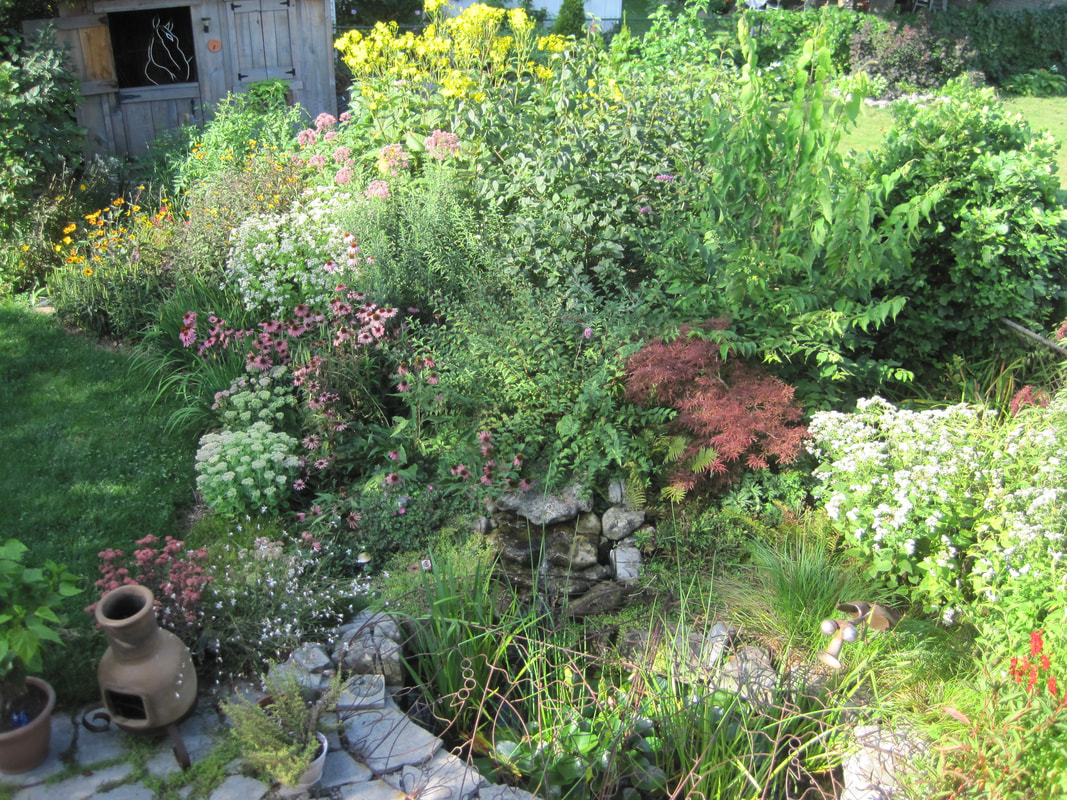 Barb's Garden Barb's Garden How can our spring gardens support pollinators and other biodiversity? That’s the guiding question we invite you to ask yourselves. We have some great advice from some of our master gardeners. Read on. Don’t get overly tidy. Mimic what you see in nature. Barb Mckean, Head of Education at RBG Think like a forest. Perennials are plants that evolved growing in the remains of their old stems and leaves. Don’t get overly tidy. Otherwise, a lot of life gets thrown away into yard waste bags in early spring (including larvae and eggs of beneficial insects and pollinators, and microscopic invertebrates, bacteria and fungi that add life to the soil and break down leaves and stems and turn them into humus that feeds new growth). Pulling away last year’s leaves means your garden starts each year with nutrient deficiencies. Mimic what you see in nature to restore natural processes that feed the soil so it can feed your plants. Be patient as eventually all those old leaves and stems will break down. Barb shares the following story from her own garden: This spring, we had a Brown Thrasher drop by in early May, on migration back from the southern US. They aren’t really a city bird, but it was able to forage for invertebrates in the leaf litter in my garden for over 48 hours. If I had followed the old-school “rules” of gardening (‘clean up leaf litter in early spring because it harbours disease’), those critters would’ve been out at the curb in a bag a month ago and that bird would have had to have moved on. Instead it found shelter and food after its journey. I posted it on the local birder’s page and Lyn Hanna Folkes responded that I had stolen her Thrasher. We have the only two naturalized yards in our neighbourhood. The bird spent Friday in her yard, then popped over to mine for Saturday and Sunday. Smart bird! 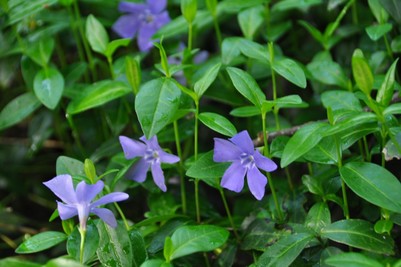 Periwinkle. It's invasive. Avoid it. Periwinkle. It's invasive. Avoid it. Avoid Invasive Plants. Lyn Hanna Folkes, Master Gardener Lyn writes: Don't plant invasive species because they can ruin your entire landscaping plan. Research each plant before you purchase it or add it you your garden. Native plants are often the best choice for many reasons. You may think Periwinkle and Lily-of-the-Valley (both invasive & non-native) are pretty and smell nice (they do!) but they can kill everything in their path and wreak havoc in natural areas. It is better to avoid them no matter how much you like them. Invasive trees like Norway Maple are also best avoided even though they are relatively inexpensive at the garden centers (weeds often are!). Very little grows underneath a Norway Maple tree, not even grass. The problems that aggressive invasive plants cause may not become evident for a number of years after planting, but then worsen far too quickly to control. So, avoid invasive plants and then you'll avoid the cost of repairing a big headache later too! Consult your local conservation authority or naturalist club for good advice about native plants, and a list of invasive plants to avoid. Lyn notes: There are so many other things we can do -- recycle everything; conserve water by storing it from all possible sources on our property for use during droughts; grow some food for yourself in your garden; use homemade compost, don't use cancer-causing chemicals in your garden; etc. The best thing we can do is think about what we are doing. Ask questions like, "Is this good for us?" Your actions make an impact on our future. If you can't answer a question, then ask others questions until you think you can make a good decision. Leave part of your garden 100% natural, no clean-ups necessary. Then watch to see where the wildlife is attracted in different seasons. Every season has its benefits in nature, even the times when there are no blossoms, there's snow or things get messy looking. Try and learn to appreciate every benefit nature provides, 'beauty' is wonderful but there is so much more! For example, birds often find food and nest building material in what gardeners "clean up" in both spring and fall. We could clean up less often and learn from simply observing nature. Learn more about things like ecology, climate change and migration, and build your garden to benefit your family's home & your neighbourhood's environment. 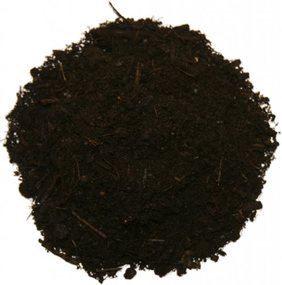 Soil is not dirt! Soil is life! Claudette Sims, Master Gardener. Claudette writes: I'd say the most important thing is the soil-most people don't pay enough attention to it. i.e. soil is not dirt! Soil is life! It is the dynamic "ecosystem" on which all plant and animal life depends. Formed from parent materials (bedrock and rock debris) broken down over eons, soil is a combination of these weathered rock fragments and newly formed clay minerals mixed with the decaying remains of plants and animals (organic matter). Air, water, soil animals and micro-organisms are the other components. Soil furnishes mechanical support, water, oxygen and nutrients for growing plants. Claudette recommends you do the following to “feed the soil, not the plants" i.e. organic matter rather than chemical fertilizers.
Improving Soil Structure • Loosens tight soils by causing tiny clay particles to form larger aggregates. • Lignin in humus helps sand particles stick together (granulation). • Greatly increases capacity to hold water; humus is spongy with tremendous surface area; can hold 90% of its weight in water. • Soil amended with organic matter warms up and dries earlier in spring and is easier to till. • Increases pore space in soil which improves soil drainage and penetration of plant roots. Her notes include the following: •Insect Friendly Clean up- Wait until daytime temperatures are in the 10’s C as many beneficial insects are sleeping in the leaf litter. If you’re cleaning up perennial beds, consider just shortening stalks, instead of removing them completely. This will help protect any native bees who may have used them for shelter. For detailed info on insect friendly spring clean up read Spring Clean up done RIGHT from Savvy Gardening. Perennials – Cut back leaving 6” (15 cm) stems for solitary bees and divide if needed. •Prune shrubs that don’t flower in spring. Keep a sharp eye out for cocoons and chrysalises when pruning. • Prune roses when the forsythia are blooming •Prune buddleia bushes to about 6” (15 cm) from ground before new growth •Lawn – Wait until your footprints are no longer visible before working on your lawn. Rake up loose/dead grass and top-dress lawn with 1/2 inch (2 cm) fine textured compost; over-seed bare spots in the lawn when lilacs bloom. If it’s too cold seed may rot. Areas with moss indicate soil has been compacted and nutrient level is likely low. Aerate and treat. Last thing for new gardeners-plant the "right plant in the right place" i.e. understand the sun/soil/water requirements of the plant before planting. Much easier to plant the correct plant, then to change the site conditions. Claudette has a nice blog you can read for more tips. 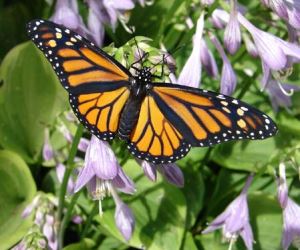 General tips. Bev Wagar, Master Gardener. Crown Point Garden Club. Monarchs Award founder. Bev writes:
25 Comments
11/18/2021 12:53:01 am
Thank you for the guide! This is going to help us out so much with keeping our customer's lawn in great shape. We service a very small, but unique area with lots of different insects. Great tips :)
Reply
1/7/2022 02:55:55 am
I just wanted to say thanks for posting such an awesome article. I found it really informative and enjoyed reading the different points of view from all of the different gardeners you interviewed. It made me want to go out and get my hands dirty and do some gardening :)
Reply
6/6/2022 06:20:58 am
What a great article about how to take good care of trees!
Reply
6/13/2022 10:26:43 am
Interesting tips. Make sure your clients should know about this.
Reply
6/14/2022 09:11:00 am
Great blog! It's always good to have new knowledge about these things.
Reply
6/20/2022 07:22:31 am
Very informative post! This will surely help anyone gain more knowledge about gardening.
Reply
10/20/2022 08:26:24 am
Thank you for the guide! This is going to help us out so much with keeping our customer's lawn in great shape. We service a very small, but unique area with lots of different insects. Great tips!
Reply
3/16/2023 02:16:54 am
Thank you for the sensible critique. Me & my neighbor were just preparing to do a little research about this. We got a book from our area library but I think I learned more from this post. I am very glad to see such fantastic information being shared freely out there. <a href="https://www.rauhane.net/">شيخ روحاني</a>
Reply
4/29/2024 07:06:08 pm
ยูฟ่าเบท789 เว็บแทงบอลที่ใหญ่ และการเงินมั่นคงที่สุด สล็อตออนไลน์ ไม่มีขั้นต่ำ ใช้ทุนน้อย เล่นได้ทุกเกม
Reply
Leave a Reply. |
Archives
December 2023
Categories |
|
|
Butterflyway Hamilton: www.facebook.com/butterflywayhamilton/
Environment Hamilton: https://www.environmenthamilton.org/ Hamilton Naturalists' Club: https://hamiltonnature.org/ |
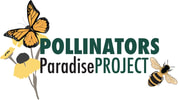
 RSS Feed
RSS Feed